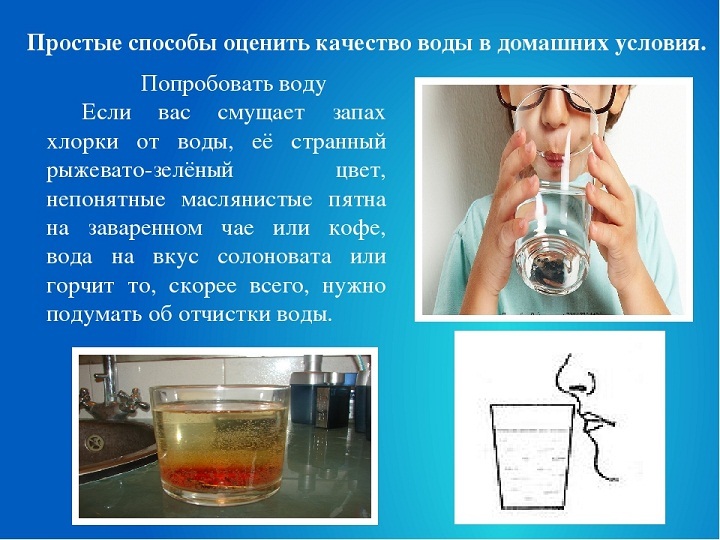In this article we will talk about methods, which will help determine the stiffness of water.
Content
- What to determine the stiffness of water: a little theory
- How to determine water hardness: Test
- How to determine the stiffness of water using a home device?
- How to determine the stiffness of water with titration?
- How to determine the stiffness of water with laundry soap?
- How to determine the stiffness of water at home with improvised means?
- Why is it necessary to sometimes determine the stiffness of water?
- Advantages and disadvantages of soft water
- Advantages and disadvantages of hard water
- What is the difference between hard water and soft water, which one to choose?
- Video: How to determine the hardness of water at home with soap?
Water is the basis of all living things on the planet, with its help all processes around and inside us occur. It has many parameters and characteristics that determine its quality, the most important of which is rigidity. You can determine the stiffness of water by the concentration of salts in its composition. Depending on this, all water is divided into soft, medium and hard. In nature, super -burning water is also found, but it is impossible to drink such water.
What to determine the stiffness of water: a little theory
Any experiments at home or in the laboratory, in this case, in order to determine the stiffness of the water, must be carried out in accordance with the established standards and in certain units of measurements.
- Calcium and magnesium crystals are salts of stiffness.It is on their concentration that the rigidity depends.
- The World Organization adopted a unit of measurement - mol/m³. But it is not very convenient in calculations, so there is still a single measuring indicator. Therefore, it is worth considering the ratio for translation. After all, each test or device has different characteristics depending on the manufacturer.
The Russian system of GOST 31865-12 approved a fixed indicator-a degree of stiffness (° F), which is tantamount to the value of milligrams-evivalent per liter (m-EKV/L). 1 ° F \u003d 1 m-ekv/l \u003d 20.04 mg CA2+ and 12.16 mg2+.
Stress degree:
- Up to 2 ° is soft water
- From 2 to 10 ° - the average indicator
- From 10 to 12 ° - hard water
- Over 12 ° - super -burned
But practice shows that already at the limit of 4-5 ° there is a scale, plaque and other deposits not only on the surface, but inside our body!

How to determine water hardness: Test
For household needs, a surface assessment is enough to determine the stiffness of water.
- Special stores are sold in stores Test strips,which can also be used if necessary. Although they do not give an accurate assessment and show the stiffness approximately, but they are affordable and simple. You can buy them in company household or pet stores.
- When lowering into the water, the color of the strip will gradually change depending on the salt concentration in water. Next, it is worth comparing the result according to the table, which manufacturers often indicate on the packaging.
The permissible error is about 1-2 °.


How to determine the stiffness of water using a home device?
- You can determine the hardness of the water using a special device that measures the electrical conductivity of the liquid - TDS meter.
- At the same time, you can find out not only stiffness, but also the presence of other impurities, electrical conductivity and even temperature (depending on the company). The main thing is good calibration, preferably 2-3 points. The color of the indicator also changes depending on the amount of salt. In addition, the salt level directly affects the electrical conductivity of fluid.
- But there is also EC-meter. It is similar to the previous device, but in addition to this will show the specific resistance of the solution in the ISMM/cm (microsymen per cm). Their testimony is slightly different due to the difference in relationships, therefore, the formula is used in terms of: tds \u003d k*ec, where k \u003d 0.67, as an average coefficient (in the range of 0.55-0.8).
- There are devices that combine their properties, but it is quite expensive, albeit very accurate. Suitable for determining water in the aquarium or for sensitive plants.
Important: filter systems based on ion exchange resin simply replace harmful calcium ions with sodium, so home experiments can show good results. TDS devices do not take into account the replacement of ions, because the general mineralization of water does not change. Therefore, there will be discrepancies in the indicators!

How to determine the stiffness of water with titration?
This can be done most accurately in laboratory conditions . Any sanitary and epidemiological station It will help you not only determine the stiffness of water, but also other indicators. Although you can conduct such experiments at home.
- To do this, we buy the desired reagent (for aquariums), pick up the specified amount of water and add a drop by dropping in circular motions.
- As a result, you get a transition from red (light pink) to a green shade. But this number of drops will help determine the stiffness.

How to determine the stiffness of water with laundry soap?
There is another fascinating experience that can be carried out at home to determine the stiffness of water. It gives an error up to 1-2 °.
- Take it 72% laundry soap. It is permissible and 60%. We measure exactly 1 g - this is approximately 1/3 tsp.
- Pour into a glass with a neck of 6 cm wide a little distilled water (literally 10-12 ml)-this is about 2 cm from the bottom. The experience is not very accurate, so the error is allowed, and a small discrepancy in millimeters is not scary. But for your convenience, glue the paper line on the outside from the beginning of the inner bottom of the glass.
- Advice: Still check the water for this experiment. Not always purchased liquid meets the requirements. Although insignificant, but deviations from the norm are possible. But in this case, experience will give a greater error.
- We heat the water so that the soap dissolves faster, and pour the chopped piece of soap. Gently, with minimal formation of the foam, mix until completely dissolved.
- Now we add to distilled water To the mark 7.2 cm From the inner bottom! If you have 60% soap, then to a line of 6 cm. Again, mix and, if necessary, remove the foam.
- We take a liter jar, collect 0.5 l of tested water. Now gently pour in soap water and actively stir with a spoon. It is worth adding a soap solution until Stable foam is formed. It can be considered such if, after the stirring of mixing, it does not immediately fall.
- Next, you need to subtract the used centimeters of soapy water and translate their necessary units of measurements according to the table.
| Degrees DH | The nature of the water | Stiffness in mg-ekv/l |
| 0–4 ° | Very soft | up to 1.5 m-EKV/l |
| 5-8 ° | Soft | 1.5–4 m-EKV/L |
| 9–12 ° | Average stiffness | 4-8 m-EKV/L |
| 13–22 ° | Hard | 8–12 m-EKV/L |
| 23–34 ° | Very tough | above 12 m-EKV/l |

How to determine the stiffness of water at home with improvised means?
- In a simpler way, you can determine the stiffness of the water Using ordinary soap. This indicator is very approximate, but it quickly shows that if a thing in a soap solution is poorly washed, and when washing off it is covered with a flake, which means the water is hard! And the softer the water, the better the foam.
- Also, a good test for water hardness is Bulstoy tea (precisely leaf, not granular), which, when brewing in hard water, turns out to be a muddy, with a dark color and has an unpleasant taste - the influence of a large amount of salts in water affects. In addition, the foam on the surface of tea is also a signal about stiffness. It usually appears after several hours.
- Scale On a teapot, washing machine, the same pipes and cranes - hard water will constantly and very quickly create a raid that will corrode enamel.
- You can drop it A drop of water on the glass or mirror. The presence of any white or yellow plaque will indicate increased rigidity.
- The abundance of salts prevents the boilment of potato and meat dishes.
- And, as the last simple advice, Try water to taste. Boil water, preferably about 5 minutes. After cooling, try:
- Sweet taste - A lot of gypsum
- Bitter - Magnesium crystals
- And tart - Abundance of iron

Why is it necessary to sometimes determine the stiffness of water?
Water production is carried out from the bowels of our land, where it is in constant contact with the soil, various rocks, minerals and substances. They also leave all kinds of impurities in the water that affect its composition, physical and chemical properties. Despite the lack of color and smell, water contains all kinds of salts, minerals, alkalis and acids.
This composition affects the stiffness of water and, accordingly, its physical properties that we notice in everyday life. And, unfortunately, even the best systems cannot completely purify water or can fail, so this process must be controlled. In addition, you yourself can determine the stiffness of water with a certain frequency at least at home.
Advantages and disadvantages of soft water
Soft water has its advantages and disadvantages. The advantages of soft water include:
- prevention of the development of urolithiasis;
- the best taste of food and drinks prepared on this water;
- a favorable effect on the skin and hair when bathing in this water;
- an increase in the service life of heating elements and various household appliances operating on this water, the lack of scale.
The disadvantages of soft water, in case of constant use, include:
- insufficient replenishment of the body with minerals;
- the probability of developing caries;
- the likelihood of developing hypertension and heart disease;
- the probability of developing diseases of the gastrointestinal tract;
- poor flushing when washing dishes and washing.

Advantages and disadvantages of hard water
Despite the fact that soft water is traditionally considered better and useful for our body, hard water also has its advantages, the main of which is to prevent the development of hypertension and diseases of the cardiovascular system. But it has much more disadvantages. These include:
- the formation of stones in the kidneys and liver;
- deposition of salts in the joints;
- the occurrence of caries;
- reduction in the service life of various household appliances operating on this water, the formation of scale and deposits in water pipes;
- hard water is slightly bitter in taste.
What is the difference between hard water and soft water, which one to choose?
From the characteristics of soft and hard water, we can conclude about the main differences, but there are still physical and chemical differences.
- Color, transparency and smell depend on the variety of salts and minerals in the composition of water. Therefore, in a yellowish color, if you put a glass with water on a white sheet of paper, you can also determine the hardness of the water. When boiling salt, the salt is precipitated and the color is equalized. Distilled water has no color, taste and smell and is a clean h 2O
It is important to say that neither one nor the other water is undesirable to consume constantly. Our body is configured for a natural balance, so the alternation of one and other water for it is perfect. Although the most optimal is still the average water indicators.








What nonsense? The article to the disadvantages of hard and soft water indicates the occurrence of caries ... I can also say that both waters are wet ...